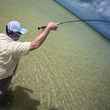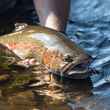Time was that my wife and I rented a place “Up North,” as we say in Wisconsin, for a week’s vacation in midsummer. The homey cottage was everything we’d hoped it would be—and it just so happened that the reef that paralleled the shore about a hundred yards out was the best place on the whole lake to fish for smallmouth.
The rental included use of the dock, along with a little aluminum boat and a pair of oars. On evenings when the weather was fair, I liked to row out after supper and peck my way down the reef with deerhair bugs. The hour before dusk is a magical time to fish for smallmouth, and a smallie exploding on a bug—the sight, sound, and feel of it—is one of those pleasures I can never get enough of.
We returned to the cottage every summer for several years, and I always caught a few bass. But then came a summer when I couldn’t buy a fish. I threw every bug in my box, even tried dredging with Clousers, but couldn’t drum up any business. I was mystified.
If you’ve fished the North Country much, it’s likely you’ve already solved the mystery. The reason I wasn’t catching bass is that they weren’t there, and the reason they weren’t there is that a certain “undesirable element” had moved into the neighborhood.
The sun was melting into the skyline pines by the time I got to the far end of the reef, the lake’s ruffled surface looking like hammered copper. I was throwing a yellow Dahlberg Diver when suddenly my antennae went up. There was something different about the water behind the fly. It was hard to put a finger on it, but it was almost as if it was vibrating. I was familiar with the concept of “nervous water,” but while I understood its implications on a bonefish flat, I was a little unclear about what it might mean on Lynx Lake in northern Wisconsin.
More Like This
I had a hunch, though.
It was over before it started. There was a ga-womph! like the sound of an aircraft carrier being launched, a washtub-sized hole appeared in the water where the bug used to be, the rod was nearly ripped from my hand and then it snapped back like the limb of a bow as the muskie razored the leader and the whole shebang went sickeningly limp.
I was tempted to utter an obscenity, just on general principle, but I was instantly resigned to this outcome. You don’t show up at a gunfight with a peashooter, and you don’t stay attached to a muskie with 12-pound mono tippet.
The really ironic thing is that I’d spent a lot of time in the preceding decade specifically trying to catch a muskie on a fly—and had failed miserably. In fact, I’d made a conscious decision that very spring to give it up, having concluded that there are a lot more enjoyable and interesting ways to not catch fish.
Now, though, the landscape had changed. Here was a muskie demonstrably willing to eat a fly, so why not take another hour out of my life and give it a shot? These twilight excursions were stolen moments anyway—I was on a family vacation, not a fishing trip—and it seemed to me that failing to act on this revelation would be like ignoring a visible sign from God.
I gave the fish a couple days to lick its wounds; then, on the last night of our vacation, I rowed back out to the far end of the reef. This time I was armed with wire bite tippet and a 1/0 chartreuse Mega Diver. It was a lovely evening, mild and still, the colors of sky and sunset pooling on the mirrored surface as if they’d dripped from the brush of Van Gogh. Casting the Mega Diver was a chore, but I was covering the water. And because I fully expected the muskie to show itself at any moment, I was laser-focused on each and every glugging retrieve.
Or at least I was until I realized it was growing dark, and that I’d whipped about five acres of water to a froth without getting so much as a half-hearted follow—a bitter microcosm of all the years I’d devoted to this feckless and quixotic enterprise.
I was about to reel up when it occurred to me that I had nothing to lose by row-trolling back to the dock. I could follow the reef almost the entire way, and when you’re dealing with as unpredictable a fish as the muskie there’s a lot to be said for simply keeping your fly in the water.
I settled into a leisurely cadence with the oars, the Mega Diver chugging along about 70 feet behind. The handle of the rod was on the seat next to me, with the tip balanced on the transom. I glanced inshore to check my position, heard a scraping noise, and turned to see my rod doing a swan dive off the stern. I’ve done a fair amount of fishing in my life, wet my line in Labrador, Alaska, and Belize, but never in my angling career have I experienced such comprehensive disbelief. The part I couldn’t believe wasn’t that I was about to lose my rod and reel, but that my half-baked plan had actually worked.
I made a frantic grab for the rod, and my first impression, as the line came tight, was that the fly had snagged bottom. But then I felt the heavy, purposeful throb that is the signature of a good fish. It stayed deep, fighting against the pressure, taking line with short, surging runs; every muskie reacts differently, so there was no telling its size. After a couple minutes of slugging it out, it changed tactics and planed towards the surface, the line sawing the water as it rose. Knowing what was coming, I reminded myself to bow to the leap.
But when the fish went airborne, all I could do was stare, dumbfounded. My “muskie” was a giant smallmouth!
A 20-incher, to be precise. It was thick through the back, deep in the belly, and hard as a slab of marble, with dark vertical bars striping its flanks and eyes as red and glowering as a goshawk’s. I’ve caught a couple smallmouth that were bigger over the years, but none that was more memorable.
The lesson being, of course, that sometimes you get what you want—even when you don’t.
































Comments